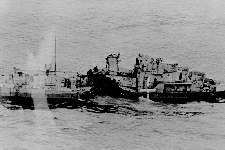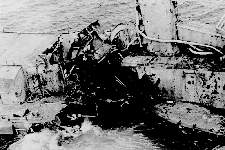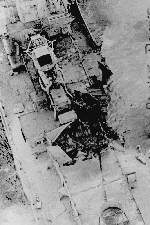Surface to air
Initial target acquisition began with the SPS-43 long range air search radar watch in the ship's Combat Information Center. If a contact appeared to be a threat the SPS-30 radar was used to determine altitude and bearing information. This information was passed to the Bridge and Weapons Control. The Officer of the Deck (OOD) on the Bridge would maneuver the ship so the superstructure would not mask the line of sight from the missile tracking radars to the target.
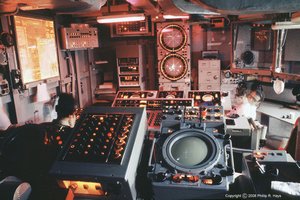
Missile firing operations were carried out in Weapons Control. When a target was designated the SPG-49 target tracking radars were activated and began a search to locate the target. When the target was acquired the range, bearing and altitude information from the SPG-49 was fed to the Mk 111 missile fire control computer to calculate an intercept point. Weapons Control determined the type of warhead to use to destroy the target and selected one or two missiles in the Area 2 ready service magazine. The missiles were then placed on the rail and moved to the Area 1 wing and fin stations. The Area 1 crews installed wings and fins on the missiles and boosters and then moved the missile to the launcher. It took about 57 seconds to move the first salvo from the ready service magazine to the launcher and be ready for firing, and about 46 seconds for succeeding salvos. Two missiles were used to engage a target in combat, but only one was fired during test shots. Only one nuclear armed missile would be fired at a time.
A launch control operator in Weapons Control used the SPS-10 surface search radar to locate all friendly ships in the launch area. The missile fire control computer displayed a probable booster impact zone circle on the radar display. The launch control operator had a joystick control that could be used to move the impact zone circle away from friendly ships - a falling booster would create quite a bit of damage if it hit a ship. The guidance computer then generated the adjusted launch trajectory.
When the Captain authorized the launch an operator in Weapons Control fired the missile(s). If two were fired they were launched one at a time, with the second following the first by one to two seconds. When a missile was launched it was essentially an uncontrolled projectile through the boost phase. Booster separation occurred after about 6 seconds at a range of about 8 miles. Because of the limited control during the boost phase Talos could not intercept targets at a range less than about 9 miles.
The missile was launched into a guidance beam transmitted from an AN/SPW-2 antenna to direct the desired flight path for the missile. After launch during the boost phase a wide guidance cone was broadcast. While the booster burned the missile did not maneuver and could wander from the beam center. After the missile separated from the booster an antenna at the rear of the missile detected the guidance signal and the missile electronics steered the missile to the center of the guidance beam. Then the beam was narrowed to provide the guidance beam to direct the missile to the intercept point. The missile(s) continued to ride the beam until the final moments before intercept.
Each ship's guidance transmitter generated a coded signal to identify the particular AN/SPW-2, allowing the missile to identify the correct guidance signal if it flew through multiple guidance beams. This code was programmed into the missile on the launcher just before firing.
To change the course and intercept point for the missile the missile fire control computer moved the guidance beam and the missile would detect its position off center and steer to follow the beam. In flight the missile did not actually fly a perfectly straight line along the beam, but wobbled or spiraled from side to side as it flew in and out across the beam center.
For short range shots (B trajectory) the missile was guided directly to the predicted intercept point. It could intercept targets flying as low as 50 feet above the surface. This trajectory was also used to avoid enemy interference (jamming) from distant sources. With medium range intercepts (A trajectory) the missile flew to a high altitude and then curved over in a long arc to dive on the target from above. On long range shots (L trajectory) the missile climbed to 70,000 feet altitude where the ram jet engine operated most efficiently and reduced air friction allowed it to cruise at Mach 2.7. At this altitude the missile had a range of 130 nautical miles (the longest actual target intercept was at 98 miles). If the target changed course the ship's guidance computer calculated a new intercept point and the SPW-2 guided the missile to the new position. This allowed the missile to stay ahead and above the target so it never had to chase the target from behind.
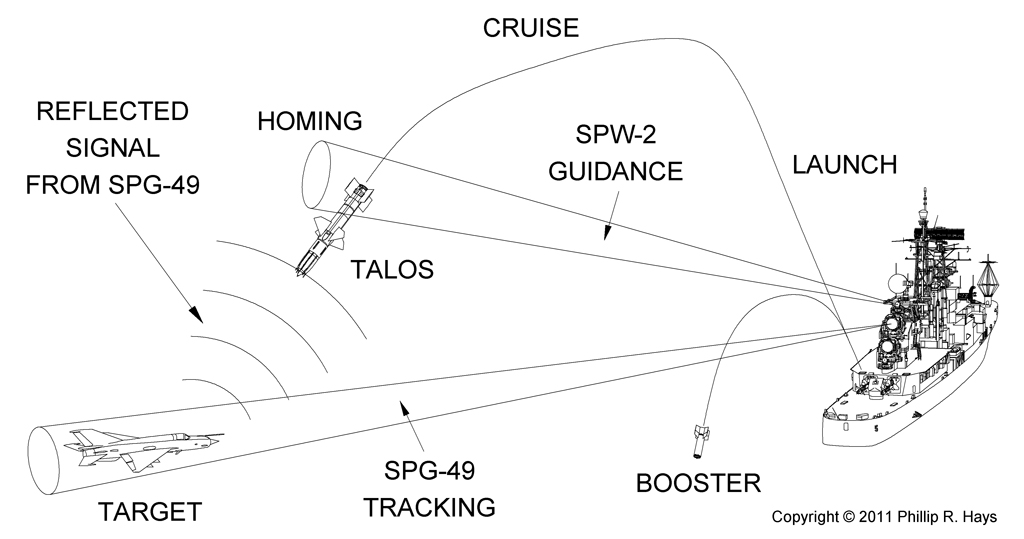
As the missile neared the target it was commanded to dive and start searching for the target. The ship's SPG-49 tracking radar radiated the pulsed tracking signal and a continuous wave (CW) homing guidance signal on a specific frequency. The ship's missile guidance computer determined the relative speed between the ship and the target and calculated the resulting Doppler shift of the reflected radar signal. It also determined the relative speed between the missile and the target, and calculated that Doppler shift. The corrected frequency information was transmitted to the missile in the SPG-49 CW beam to tell it what homing signal frequency to look for. This made the missile essentially "jam proof." It would home on the correct signal and ignore all others. The only way to interfere with the missile was to jam the SPG-49 tracking radars, and cause the ship to lose the target. This was difficult to accomplish if a skilled operator was at the SPG-49 controls.
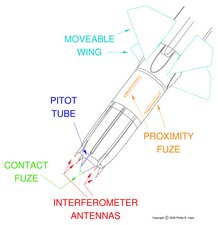
Four homing guidance antennas were located around the nose of the missile. These antennas were made of fairly fragile ceramic, and were protected by covers
made of low melting temperature metals. Friction with the air during flight generated heat that melted the covers and exposed the antennas. The four antennas
functioned as an interferometer to determine the angle to the target. The continuous wave
homing signal that was sent by the ship reflected off the target. When the missile began closing the target the signal was detected by the homing antennas.
Antennas on opposite sides of the missile were paired, and each pair was associated with the controls for a pair of moveable wings, also on opposite sides of
the missile. The missile's electronics determined the time difference between when a signal arrived at the two antennas in a pair. If the missile was headed
for a collision with the target the time difference would not change - the relative bearing from the missile to the target was constant. If the time
difference changed the electronics would turn the wings associated with the antenna pair to bring the time difference back to the original, steering the
missile back on a collision course. Using the time difference signals from the two pairs of antennas the missile steered a constant bearing, decreasing range
trajectory that would lead to a collision with the target. If the target maneuvered the missile changed course to follow the reflected signal. This was a
fairly simple system that could be built with the vacuum tube electronics common in the 1940s and 1950s, but it provided an effective means of guiding the
missile to the target.
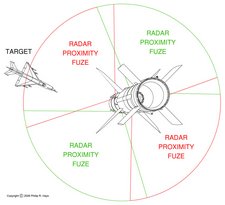
Talos cruised at a higher altitude than most aircraft could fly. In the final phase of intercept it dove on the target from above, exposing the maximum target surface area to the radar proximity fuzes. Most surface-to-air missiles approached the target from below so pilots weren't expecting an attack from above. As the missile approached the target the four proximity fuze radars positioned around the missile broadcast a "hollow" funnel-shaped conical signal forward. Targets directly ahead of the missile would be inside the funnel and would not reflect the fuze signal. As long as the proximity radars did not detect a proximity fuze signal reflection from the target the missile continued to home on the target. If the missile collided with the target the contact fuze in the nose detonated the warhead. If the missile did not make skin-to-skin contact, as it flew by the target the proximity fuze signal cone would sweep over the target and the reflected signal caused the warhead to detonate. The warhead's expanding rod swept outward along the proximity fuze signal cone and hit the target.
If a large number of aircraft were attacking in a group a nuclear warhead could be used. The launch and cruise phases were similar to a conventional warhead shot, but there was no homing phase. The computer guided the missile to the center of the target group and detonated the warhead on command.
Here is a three minute recording of a Talos launch and drone intercept at a range of about 25 miles. I recorded this from inside the missile house Area 1 during a test firing exercise off Okinawa. The previous two attempts had been canceled, one because of equipment problems and the other because an airliner flew into the missile range. That's why the missile house crew was a bit skeptical that we would launch that afternoon.
Surface to surface ship targets
Engagements with ship targets were similar to surface to air shots, and used a conventional warhead. Because the target had to be illuminated by the SPG-49 radars, the target could not be over the horizon. This limited the effective range to less than 25 miles, depending upon the size (height) of the target. Only a very small part of the target had to be visible above the horizon.
The missile followed a normal launch phase and a short cruise phase. It dove almost straight down onto the target, homing on the reflected signal from the SPG-49s. The missile detonated on contact with the target. Because of the large size and slow speed of ships, the missile couldn't miss. The high dive angle produced the most effective possible explosion inside the target.
In 1968 the Okie Boat participated in an exercise off California in which a mothballed destroyer escort (DE) was used as a target. After a day or two of other ships and aircraft shooting at the hulk with guns and missiles the Oklahoma City launched one Talos missile carrying a dummy warhead. The missile's 1500 Kg (3300 lbs) of magnesium alloy airframe and aviation gasoline traveling at Mach 2.5 (1800 mph) possessed enough kinetic energy to sink a ship, even without a warhead.
These pictures show the huge hole in the DE where the missile slashed through the ship. The missile came down almost vertically, striking amidships just aft of the funnel, exploding in the boiler room and engine room. The explosion blew out a large wedge cutting through two thirds of the main deck and continuing through the bottom of the ship. After this hit the ship broke into two parts and sank. Damage would have been even greater if the warhead had carried explosives!
It is interesting to compare the Talos round to a projectile from a battleship. The missile normally carried the Mk 46 continuous rod warhead. In this configuration the missile weighed about 3300 pounds, and the warhead carried 225 pounds of TNT/RDX explosives. For comparison, a Mk 13 16" HC projectile (fired from the Iowa class battleships) weighed 1900 pounds and carried 154 pounds of Explosive D (ammonium picrate). The Talos round was half again as massive as the battleship projectile, carried half again as much explosive, traveled at more than twice the impact velocity, had a greater range, and didn't miss. Clearly, the Talos round would cause far greater damage.
Surface to surface shore targets
The Talos missile could be used to attack targets on land. If the target was a shore facility a nuclear warhead equipped missile would be selected from the Area 2 ready service magazine. The launch and cruise phases were similar to a long range air intercept except the missile guidance computer did not use a tracking signal from the SPG-49 radars. Instead a course calculated by the PDP-8 Surface Trajectory Computer was used to control the SPW-2 guidance antennas. The terminal phase was quite different because the missile had no signal to home on. Instead the ship's guidance computer commanded it to dive to the target when the missile reached the calculated position. The warhead was detonated on command from the ship when the missile descended to the appropriate altitude. The missile had to be within the line of sight of the guidance radar, so the maximum range depended upon the desired burst height. Typically the maximum range was about 40 miles. This targeting method was rather imprecise, but with a nuclear warhead close is good enough.
Anti radar targets
Anti radiation RGM-8H shots were similar to surface to surface shore target shots except for the terminal guidance phase and a conventional warhead. Radar targets could be engaged out to the full 130 nautical mile range of the missile. Target direction, range and signal characteristics were provided by the ship's electronic intelligence personnel. The launch and cruise phases were normal. When the missile approached the target area it was commanded to start looking for a specific radar frequency characteristic of the target radar. When the enemy radar signal was acquired the missile used the normal interferometry guided constant bearing, decreasing range procedure to home on the transmitting antenna. Warhead detonation was caused by the nose contact fuse.
The USS Oklahoma City (CLG-5) conducted the first successful Talos combat anti radiation shot. This was also the first successful surface to surface combat missile shot in US Navy history.
Nuclear armed missile firing procedure
Conventionally armed missiles were launched at the Captain's discretion according to the tactical situation. They were loaded onto the launcher and fired from Weapons Control by pushing a few buttons and pulling the firing trigger. For nuclear armed missiles there were safeguards to prevent unauthorized launching.
Nuclear weapons were to be prepared for use and expended only upon orders from higher command. Elaborate security measures were used to prevent unauthorized orders. Nuclear weapon movement and expenditure messages were transmitted over a scrambled sixteen channel frequency hopping network. A computer on the ship controlled the transmitters and receivers, using a rapidly changing frequency sequence that was reprogrammed several times a day. Any fake message that did not use the proper frequency hopping scheme would not be received.
The ship carried copies of the Top Secret Pacific Fleet General War Plan that described operations to be conducted in time of war. Annex Uniform detailed specific missions in which nuclear weapons would be used. For land targets the message contained the geographic coordinates of the target. Each mission description included the precise format, wording and coding for the message authorizing execution of the operation. All operations involving nuclear weapons would be initiated by these messages. Messages concerning the use or movement of nuclear weapons would be compared to the appropriate section of Annex Uniform. Messages that did not have the exact format would be considered fake, and would be ignored. This was the first step toward preventing unauthorized use of nuclear weapons.
Nuclear weapons expenditure messages contained a multi-character Sealed Authentication System (SAS) Authentication Code. The ship carried a collection of SAS Authenticators in a SAS safe within a restricted security area in the Communications Center. The SAS safe had outer and inner doors, each secured with a combination lock. The ship had two Sealed Authentication System Teams, each with the combination to one of the doors of the safe. No one outside each team knew the combination, and the combinations were changed periodically. One member of each team was aboard at all times. When a nuclear operations message was received the SAS teams would open the safe and remove the SAS authenticator. These were laminated packets about the size of a playing card. When twisted they popped open revealing the SAS code. The SAS team compared the code from the sealed Authenticator with the SAS code in the message. If the codes matched the message was valid.
At this point several key officers and the Captain knew that the ship had received valid orders to expend nuclear weapons. Several other security provisions prevented unauthorized operations on board the ship.
Normally the nuclear armed Talos missiles were stored in the Area 3 Missile Magazine. They were not mated to boosters in the magazine and could not be launched. Nuclear missiles would be moved to the Area 2 Ready Service Magazine only on orders from fleet command when there was eminent threat of nuclear war. This required moving a missile and a booster from Area 3 to the mating area in Area 2, assembling them, and then moving the missile/booster into a tray in the Ready Service Magazine.
There were three additional safeguards to prevent accidental or unauthorized launching of a nuclear missile. First, nuclear armed missiles were stored in the Area 2 Ready Service Magazine with an antiloading fixture locked onto the rear booster shoe. This would physically prevent the missile from being placed onto the launcher rail. The fixture could be unlocked with a key that was carried by the Weapons Officer. Then the missile could be moved into the Area 1 Wing and Fin Area.
Second, nuclear armed missiles carried a green Safing Plug while in the magazines. The launching system could detect the Safing Plug while the missile was in the Wing and Fin Area and would not allow it to go to the launcher with the Safing Plug installed. This plug had to be replaced with a purple Arming Plug. The purple plugs were stored in two safes located in Area 1. Only the ship's Captain had the combination to the safes. After the combination was passed from the Bridge to Area 1 the safes were opened and the green Safing Plug was replaced with a purple Arming Plug. The system allowed a nuclear armed missile to move to the launcher only if the purple Arming Plug was installed.
Third, the launch control console in Area 1 had a switch with a large "T" shaped handle. A similar switch was located inside a locked enclosure in Weapons Control. The locked enclosure was opened by a key carried by the the Weapons Officer. Both the Weapons Control and the Area 1 switch handles had to be rotated a quarter turn to the "Launch" position at the same time to enable the launch control system to move the nuclear armed missile out to the launcher. The handles were spring loaded and would return to the "Safe" position when released.
While both "T" handle switches were held in the launch position a man at a separate control panel in Area 1 (some distance from the launcher control panel) pushed a button to open the blast doors and move the missile from Area 1 to the launcher. Each of the six wing and fin men had to step behind protective screens and depress their foot switches (to signal that they were out of the path of the missile) to allow the missile to move onto the launcher.
After the missile was on the launcher the normal firing procedure could be carried out. The missile was fired by a trigger on the Guided Missile Firing Panel in Weapons Control. The ship's Guided Missile Computer directed the missile to it's target area and sent a signal to detonate the warhead.

